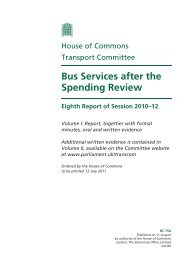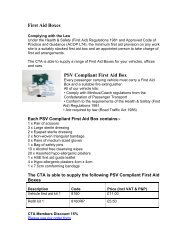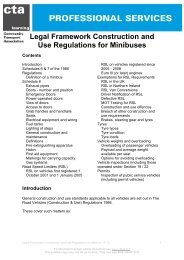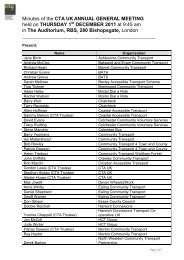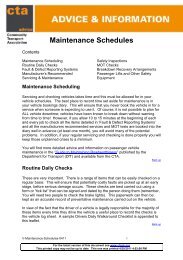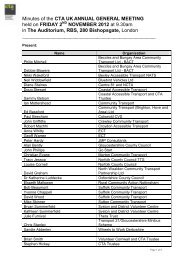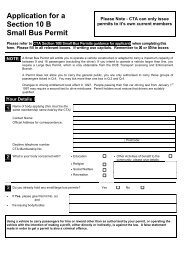We care do you? - Community Transport Association
We care do you? - Community Transport Association
We care do you? - Community Transport Association
Create successful ePaper yourself
Turn your PDF publications into a flip-book with our unique Google optimized e-Paper software.
Why <strong>do</strong> I need to trainmy drivers?The Health and Safety Executive nowregards driving as one of the mostdangerous regular activities that mostpeople <strong>do</strong>. Statistically, working as adriver is almost as dangerous as being adeep sea fisherman or working in a quarry,and more dangerous than working in theconstruction industry.Under the Health and Safety atWork etc Act 1974, organisations havea responsibility to provide information,instruction, training and supervision to alltheir staff, and a responsibility to protectthe health, safety and welfare of everyoneaffected by the organisation. This is furtheren<strong>do</strong>rsed under the Management of Healthand Safety at Work Regulations 1999,which also place a duty on organisations toprovide appropriate training to staff.So there is a clear, legal, obligation toensure <strong>you</strong>r drivers are trained.> What are the benefits oftraining my drivers?Besides the obvious legal requirementsthere are other benefits, not only to <strong>you</strong>rorganisation but also to <strong>you</strong>r drivers andpassengers. Trained drivers will drive <strong>you</strong>rvehicles in a more sympathetic manner,thus helping to reduce maintenance andfuel costs. They will have fewer accidents,resulting in lower insurance premiums andless “<strong>do</strong>wn-time” of vehicles. The skills theylearn during training can be transferred totheir own vehicles, with the same potentialreduction in running costs. Perhaps themost significant benefit of all is to <strong>you</strong>rpassengers, who will be transported in asafe and comfortable manner.So there are far more reasons fortraining than simply because the law says<strong>you</strong> have to.> I can see that I need to trainpaid staff, but what aboutvolunteers?In the publication Charity and VoluntaryWorkers: A Guide to Health and Safetyat Work, the Health and Safety Executivestates: “In general, the same healthand safety standards should be appliedto voluntary workers as they would toemployees exposed to the same risks.”There may not be strict legal duties butthe implication from this statement is clear,<strong>you</strong> should offer the same level of trainingto a volunteer driver as <strong>you</strong> would to apaid one.There are also other reasons for trainingvolunteers, not least of which is makingthem feel a valuable part of the team byreceiving the same training as other staffmembers. You may also find it easier torecruit, as potential volunteers are morelikely to come to an organisation thatobviously <strong>care</strong>s about its voluntary staff,and of course, <strong>you</strong> may find it easier tohang on to them once <strong>you</strong>’ve got them!> OK, so I need to train all mydrivers, what should I <strong>do</strong>?The simple solution to <strong>you</strong>r driver trainingneeds is to join MiDAS.MiDAS is the award-winning* MinibusDriver Awareness Scheme, organised bythe CTA. MiDAS is a nationally recognisedstandard for the assessment and trainingof drivers. It is a membership scheme,which is free to join, that has beendesigned to enhance driving standardsand promote the safe operation of thesevehicles. It is a membership scheme,2 Training <strong>you</strong>r drivers



